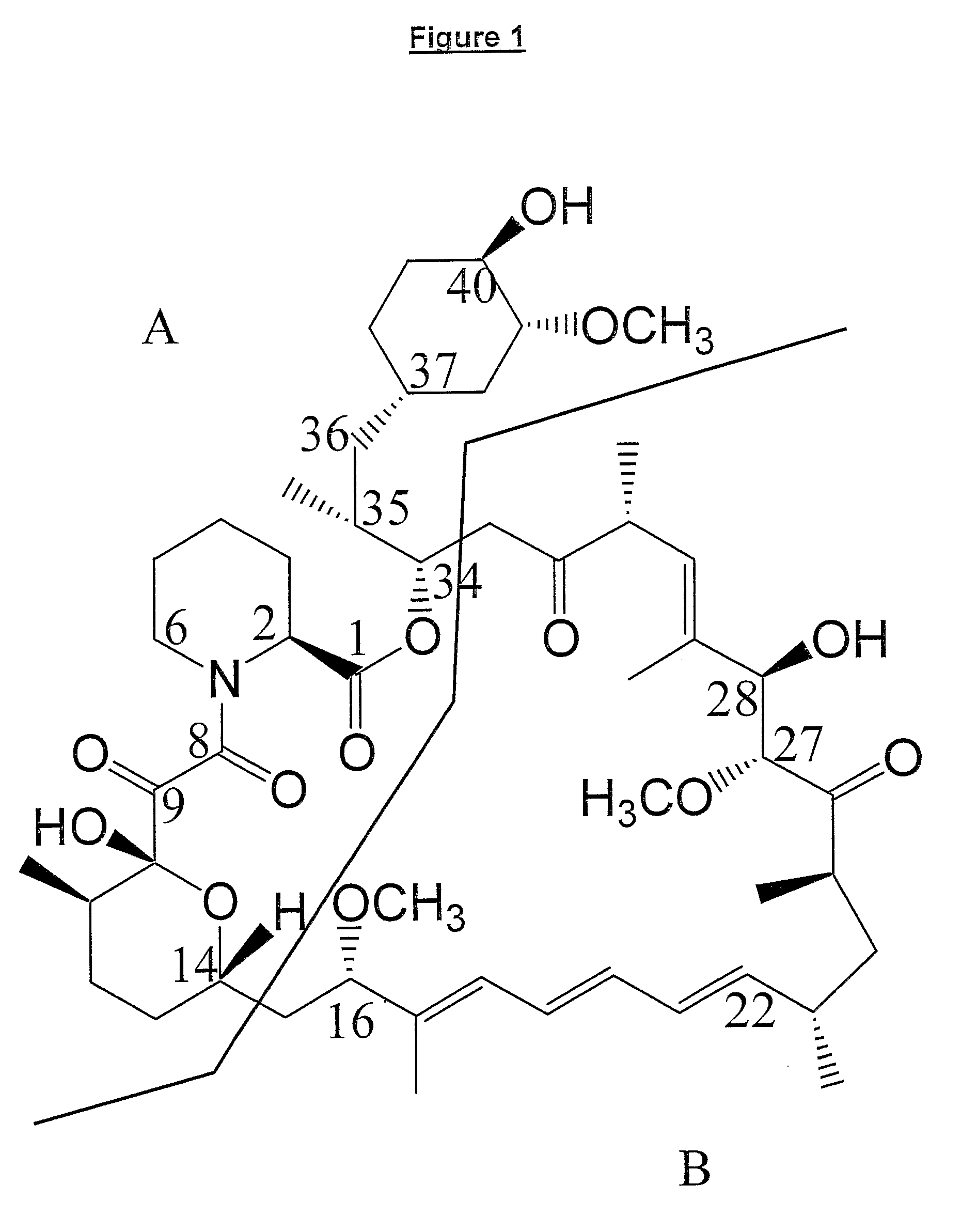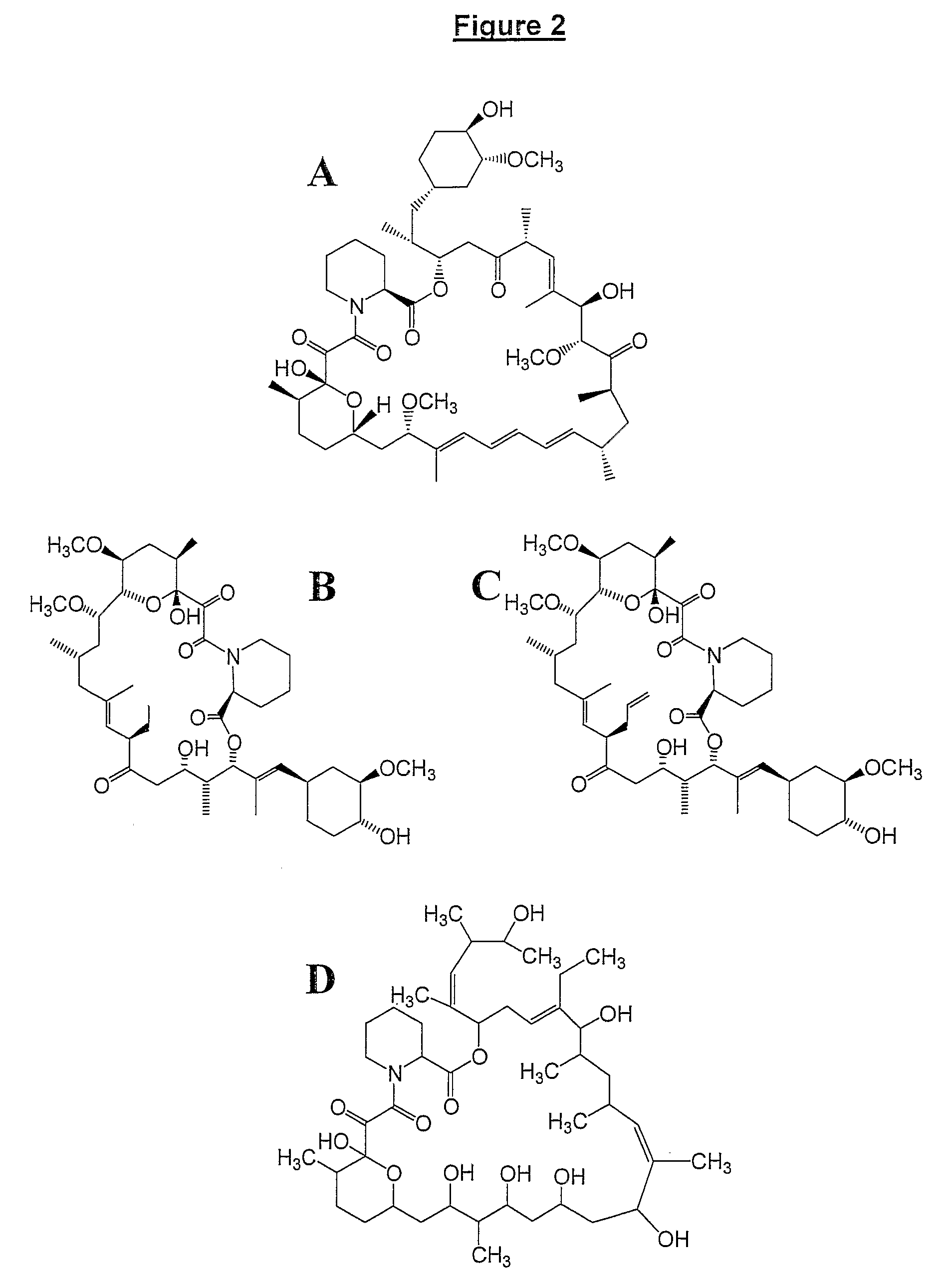Production of polyketides and other natural products
a technology of polyketide and natural products, applied in the field of polyketide and other natural products, can solve the problems of limited utility, difficult site selection, and difficult work
- Summary
- Abstract
- Description
- Claims
- Application Information
AI Technical Summary
Benefits of technology
Problems solved by technology
Method used
Image
Examples
example 1
Isolation of the Engineered Strain S. hygroscopicus MG7-9
i) Generation of Plasmid pALK83
[0411]Primers MG308 5′-GTCCTAGGTGATGTCCCGGCAACACG-3′ (SEQ ID NO: 13) and MG309 5′-CACCTGCAGGCCCAACTCGGCCAGCTCGCT-3′ (SEQ ID NO: 14) were used to amplify a region of homology upstream of the Rapamycin module 10 acyl transferase (rapAT10) (from nt11693 to nt13289 in the rapamycin cluster as described in Schwecke et al., 1995) using cosmid DNA (cos 26, see Schwecke et al., 1995) prepared from S. hygroscopicus NRRL5491 as a template. The 1596 bp PCR product (SEQ ID NO: 15) was phosphorylated using T4 polynucleotide kinase and ligated into SmaI digested pUC18 which had been dephosphorylated. After transformation into E. coli DH10B, the plasmid pMG255-4 was isolated. The primers MG310 5′-CCTGGCCAGGAAAGACGAACACGATCCT-3′ (SEQ ID NO: 16) and MG311 5′-CGAAGCTTGAGCCGCTGGCGATCGTGGGA-3′ (SEQ ID NO: 17) were used to amplify a region of homology downstream of the Rapamycin module 10 AT (from nt14191 to nt15742 ...
example 2
Array Feed of Starter Acids to S. hygroscopicus MG7-9
[0424]
TABLE 3Sources of acids for use in the array feeding experimentCom-StockAcidpanynumbersynthesiscyclohexanecarboxylic acidAldrich10,183-4(1R*,3R*,4R*)-3,4-in housedihydroxycyclohexanecarboxylic acidbymethod A1-cyclohexenecarboxylic acidAldrich32,836-73-cyclohexenecarboxylic acidAldrich45,375-7cycloheptanecarboxylic acidAldrichC9,850-0ethyl (1R*,5R*)-5-hydroxycyclohex-3-in houseenecarboxylatebymethod Bethyl (1R*,4R*)-3-fluoro-4-in househydroxycyclohexane carboxylatebymethod C3-(cis / trans)-Aldrich33,061-2methylcyclohexanecarboxylic acid
Method A: Synthesis of (1R*,3R*,4R*)-3,4-dihydroxycyclohexanecarboxylic acid
[0425]
[0426](1R*,3R*,4R*)-3,4-Dihydroxycyclohexanecarboxylic acid was readily attainable from commercially available racemic 3-cyclohexene carboxylic acid. This acid was epoxidised through treatment with meta-chloroperbenzoic acid and converted to the (1R*,3R*,4R*)-4-hydroxycyclohexane-1,3-carbolactone in situ by the addi...
example 3
Construction of Conjugative Vector pLL150
[0434]Plasmid pSGset1 (WO 04 / 007709) was digested using SpeI and BstEII and the 2.481 kbp fragment was isolated and ligated with vector pRT801 (Gregory et al., 2003) similarly digested with SpeI and BstEII. After transformation into E. coli DH10B, colonies were screened by restriction enzyme digestion and the final plasmid pLL150 was isolated. See FIG. 8.
PUM
| Property | Measurement | Unit |
|---|---|---|
| temperature | aaaaa | aaaaa |
| pH | aaaaa | aaaaa |
| total volume | aaaaa | aaaaa |
Abstract
Description
Claims
Application Information
 Login to View More
Login to View More - R&D
- Intellectual Property
- Life Sciences
- Materials
- Tech Scout
- Unparalleled Data Quality
- Higher Quality Content
- 60% Fewer Hallucinations
Browse by: Latest US Patents, China's latest patents, Technical Efficacy Thesaurus, Application Domain, Technology Topic, Popular Technical Reports.
© 2025 PatSnap. All rights reserved.Legal|Privacy policy|Modern Slavery Act Transparency Statement|Sitemap|About US| Contact US: help@patsnap.com



